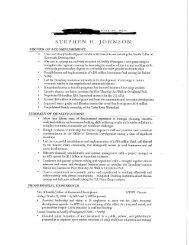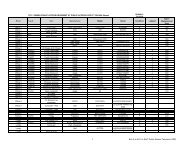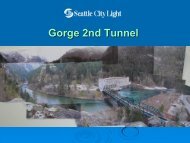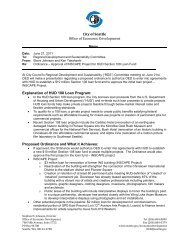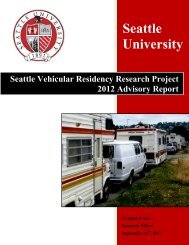2013 Water System Plan, Volume II - Seattle City Clerk's Office - City ...
2013 Water System Plan, Volume II - Seattle City Clerk's Office - City ...
2013 Water System Plan, Volume II - Seattle City Clerk's Office - City ...
Create successful ePaper yourself
Turn your PDF publications into a flip-book with our unique Google optimized e-Paper software.
The area is on a steep slope and particularly if the water main is to be in an area<br />
determined to be a slide area.<br />
If the site is congested with underground utilities or other facilities such that<br />
concrete thrust blocks are unfeasible.<br />
To provide flexibility in shutdown areas and avoid using temporary thrust<br />
restraints.<br />
In areas where excavations, soil settlement or subsidence is anticipated,<br />
restrained joint pipe should be considered.<br />
In pipelines critical to the functioning of the water supply system after a major<br />
seismic event.<br />
i<br />
ii<br />
Wedged Restraints<br />
Other examples of flexible restrained joints are a wedge restraint gland type device or a<br />
restrained gasket type of pipe. Wedge restraint glands must follow Standard<br />
Specification 9-30.5(5)B. Wedge restraint glands are typically used on mechanical joint<br />
pipe and fittings and grip the pipe, which forces a lug with teeth to imbed into the pipe.<br />
Most wedge restraint systems remain flexible after installation.<br />
Gasket Restraint<br />
The restraint gaskets are readily available and can be installed on field-cut push-on joint<br />
pipe. The restraining gaskets have stainless steel teeth imbedded in them that grip the<br />
pipe for restraint. The restraint gaskets are only pseudo-flexible restrained joints. Once<br />
assembled, they offer little or no deflection capability. They also require special tools to<br />
disassemble.<br />
Note: SPU has used the restraint gaskets on occasion, but found they do not save costs.<br />
The AWWA M41 Manual or DIPRA computer program can be used to calculate ductile<br />
iron pipe restraint requirements.<br />
Restrained joint pressure ratings for each type and pipe size must be verified with the<br />
manufacturer. The length of pipe in casings on any run of ductile iron pipe does not<br />
count towards its overall restraint length, unless the casings are filled with grout after<br />
the pipe is installed. When using restrained joint pipe, all pipe in each individual system<br />
must be restrained joint. In addition to pipe joint restraint, concrete thrust blocks must<br />
be provided unless site-specific conditions do not allow.<br />
Note: Field cutting and modifying a factory restrained joint pipe is difficult and time<br />
consuming. The pipe must be ordered specific to the project site. Contractors must<br />
submit and receive approval of a 3-D lay plan before ordering pipe.<br />
iii Grooved Restraint<br />
Grooved restraint couplings can be used to restrain ductile iron and steel pipe. These<br />
couplings are uncommon in the SPU system but can be found on some blow-off<br />
facilities. Grooved restraint couplings are generally not used in buried service.<br />
The standard grooved restraint coupling engages a groove that is cut on the exterior of<br />
the full circumference of the pipe. Thicker pipe must be used for these couplings.<br />
5-28 SPU Design Standards and Guidelines



